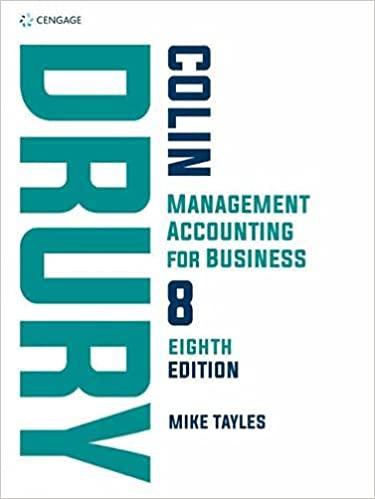Question
Background: Performance Drinks, LLC is owned by Dave N. Port. Performance Drinks produces a variety of sports centered drinks. They began operations in 1993 shortly
Background:
Performance Drinks, LLC is owned by Dave N. Port. Performance Drinks produces a variety of sports centered drinks. They began operations in 1993 shortly after Mr. Port graduated with his M.B.A. from Davenport University. The company saw early success as sports and fitness nutritional products gained new popularity in the 1990s. Financially the company is sound and has been wise in controlling their growth over the years. However, within the last 18 months Mr. Port has noticed a drop in overall company profitability. This is especially troubling considering that the company has continued to experience top-line growth. Mr. Port and his management team have been considering developing a new product line. However, those plans have been put on hold until they can figure out why their profits are shrinking.
Performance Drinks makes four different kinds of sports drinks. Those drinks are as follows:
Basic
Hydration
Intensity
Post-Workout
Each of these drinks contains a slightly different nutritional profile and is targeted for different users and uses. The Basic drink has the least nutritional benefit and is targeted for general consumption. The Hydration product targets endurance athletes and specializes in hydration replacement. The Intensity product was designed with energy enhancement in mind. It serves the needs of extreme athletes who need long durations of sustained energy. Lastly, the Post-Workout product is a nutritional replacement product that is generally used following exertion.
Information Related to Case #2
You are the Controller for Performance Drinks. You feel as though you have a good handle on the financial reporting and the overall company performance. However, admittedly, your accounting information system has been designed to serve the needs of external users from an aggregate perspective. To that end you utilize absorption costing exclusively within the organization. You recall studying the concept of Activity Based Management (ABM) and Activity Based Costing (ABC) while taking a managerial accounting course. You wonder if applying those ideas to your business would help to uncover the mystery of the disappearing profits.
You recall from your Management Accounting class that product costs are comprised of:
Direct Materials
Direct Labor
Manufacturing Overhead
You dont suspect that anything strange is going with your direct costs. You do wonder, however, if a more thorough understanding of your indirect costs may be in order. Over a series of weeks you talk with a variety of employees, representing a multitude of functional areas, from within the company. During those conversations you take careful note on what activities might be consuming resources and how those activities might be measured. You sharpen your pencil and begin to unpack what youve learned. You start with reviewing last months Product-Level Profit Report. That report is following:

Overhead Activities:
Using traditional costing methods, which support your absorption costing system, you base overhead allocation on direct labor cost. Furthermore, fringe benefits are a function of direct labor cost.
As a result of your many meetings to discuss company overhead you determine that the majority of your indirect costs are related to four primary activities. Those activities are equipment set-ups, production runs, production management and machine-hour capacity. Production Management refers to a number of items that are correlated to the number of products the company produces. Ultimately you determine that your key activities have the following usage patterns, as they pertain to the monthly overhead costs:

New Information Pertaining to Case #3:
The financial reporting to date has been done using absorption costing. That is to say that the manufacturing costs included direct materials, direct labor, variable manufacturing overhead and fixed manufacturing overhead. In this sense the Income Statements have historically reported Gross Margin. Following is a Monthly Income Statement, based on absorption costing, for Performance Drinks:

You begin to wonder if there would be any value in repackaging the income statement in a way that would report Contribution Margin as opposed to Gross Margin. You know that in order to report Contribution Margin you will need to understand your costs as variable and fixed. Unfortunately the general ledger does not specifically report costs as variable and fixed. You remember learning that regression analysis can be used to generate data that can be used to create a total cost equation. With the total cost equation we can understand our total cost as the sum of fixed costs and variable costs. After doing some research your collect the following data related to overhead and possible causal factors:

Here is the answer I got for requirement 1,2 and 3 which you will need for requirement 4
Answer for requirement 1
Using the data above, which has also been provided electronically in Excel, run the following regression analyses:
Linear regression analyzing total overhead cost and units sold

Linear regression analyzing total overhead cost and machine hours used

Multiple regression analysis analyzing total overhead cost along with both units sold and machine hours used
 .
.
PLEASE HELP WITH REQUIREMENT 4
Requirement #4
Create a Contribution formatted income statement using the results from the multiple regression test. Your selling price per unit and your direct material cost per unit and your direct labor cost per unit and your fringe benefits all come from the original Traditional income statement. Use the following additional information regarding machine hours, used by each product, to compute variable overhead.

Step by Step Solution
There are 3 Steps involved in it
Step: 1

Get Instant Access to Expert-Tailored Solutions
See step-by-step solutions with expert insights and AI powered tools for academic success
Step: 2

Step: 3

Ace Your Homework with AI
Get the answers you need in no time with our AI-driven, step-by-step assistance
Get Started


